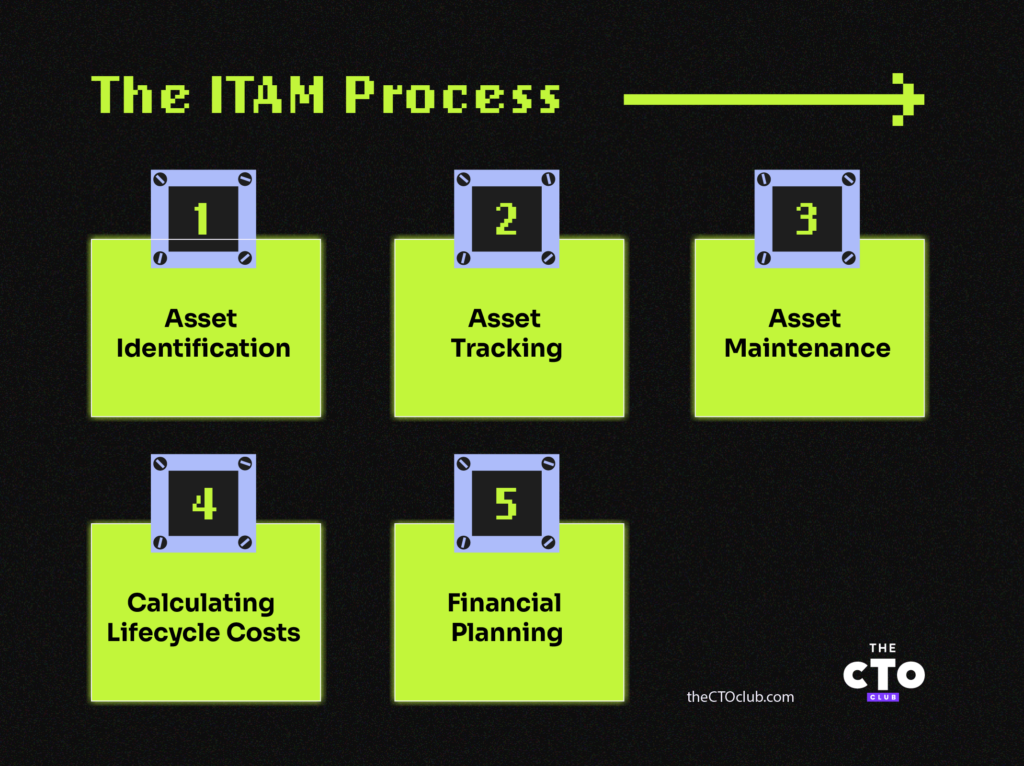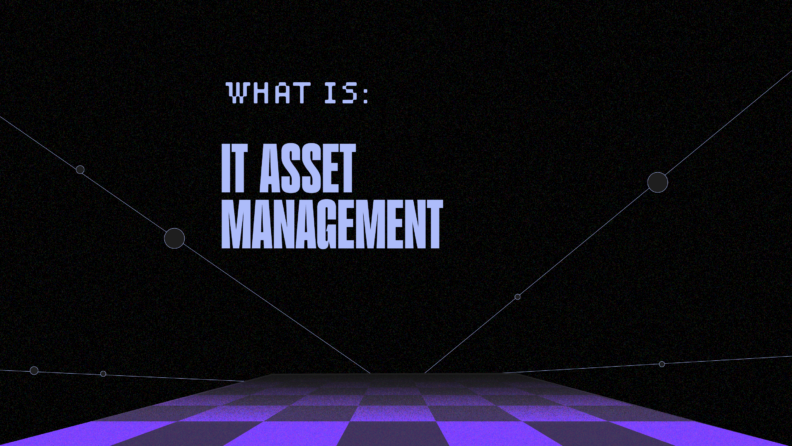IT asset management (ITAM) ensures a precise understanding of the lifecycle costs and risks associated with technology assets. This clarity is essential for enhancing the business value derived from decisions related to technology strategy, architecture, funding, contracts, and sourcing.
As a SaaS CTO, you’ve got a lot on your plate. You need to optimize cloud infrastructure costs, be on top of software licenses, and do it while giving your company a competitive edge. That’s where IT asset management (ITAM) comes in.
Streamlining IT asset management is challenging, but proper asset management is the cornerstone of an efficient IT environment.
What is IT Asset Management?
At its core, ITAM is the ongoing cycle of managing the life of IT assets from acquisition to retirement.
Tracking is just one part of IT asset management. When done well, ITAM provides you with a lens through which to view and harness the full potential of your assets, maximizing their value and minimizing waste while ensuring compliance in the area of licensing.
ITAM also has broader benefits for many organizations, helping align IT resources with business goals, controlling costs, and making cybersecurity more manageable. Good asset management allows for informed decision-making, procurement, and infrastructure management.
IT Asset Examples
IT assets can be divided into several key categories:
- Hardware assets: This category covers typical hardware such as servers, desktops/laptops, and keyboards but also includes mobile devices, IoT devices, and more specialized items such as VR or AR headsets, drones, etc.
- Software assets: Software licenses for desktop applications, subscriptions for Microsoft Office or Adobe software, and other software usage licenses may be managed per account/seat or install basis.
- Digital assets: Domains, API keys, and other digital identifiers fall under the umbrella of digital assets. These must be monitored carefully. API keys, for example, may be restricted to a certain number of calls per day/month.
- Personal insight: An often overlooked area of ITAM is knowledge of undocumented practices. Shadow IT practices are a common issue, especially in large organizations. Addressing shadow IT can help improve an organization’s cybersecurity. When auditing your IT environment, investigating workflows at a department level to identify areas of shadow IT is essential. Individually, shadow IT practices may seem harmless. Still, over time, they can create security concerns or cause unexpected issues if the person who created the undocumented system leaves the company and stops maintaining it.
Why ITAM is Essential
IT asset management involves the dynamic utilization of gathered asset data to enhance returns, reduce risks, and amplify business value. Through strategic avoidance of superfluous asset acquisitions and optimal utilization of existing resources, IT asset managers can reduce software licensing and support expenses. This approach curtails unnecessary spending and elevates operational efficiency by eliminating waste.
- Providing a Single Source Of Truth – Often, IT assets are tracked across multiple platforms by various individuals, leading to a lack of ownership and centralized data. This fragmentation results in chaos and inaccuracies, hindering informed decision-making. In some companies, employees are dedicated solely to monitoring IT assets—a task better suited for systems. By shifting the focus from manual tracking to strategic initiatives, IT staff can contribute more significantly to organizational goals. Asset management introduces order and provides a consolidated source of truth for IT teams, management, and the entire organization.
Enhancing Utilization and Reducing Waste – Effective asset management ensures up-to-date information, enabling teams to optimize resource use and reduce waste. It aids in avoiding unnecessary expenditures, lowering licensing and support costs. Moreover, it ensures adherence to security and legal standards, minimizing risks. The resultant cost savings and productivity gains are beneficial for the entire organization.
- Fostering Productivity While Ensuring Reliability – As digital transformation reshapes operational methods, asset management extends beyond mere tracking of hardware. Embracing DevOps and SRE principles, teams require robust asset management systems to swiftly deliver new services without sacrificing reliability. Using a solution like ServiceDesk Plus, ManageEngine's flagship IT service desk software, you can gain visibility into and control over IT assets and costs. Effective asset management allows for precise control, reducing overprovisioning and idle instances, thus curtailing unnecessary expenses.
Understanding the ITAM Process

IT asset management (ITAM) is an ongoing process, not a one-time project. It requires regular execution and adaptation as assets, objectives, and tools evolve.
The IT asset management process typically encompasses these key steps:
- Asset Identification: The initial phase in ITAM is to compile a comprehensive inventory of all IT assets. This step is crucial for easy recognition of assets and ensures that any redundant assets are effectively optimized to boost efficiency.
- Asset Tracking: This step involves using an ITAM tool or system for ongoing surveillance of IT assets. The tracking process gathers various types of data for each asset, including financial details (such as asset costs), contractual information (like warranties, licenses, and service-level agreements), and inventory specifics (covering the location and condition of physical assets).
- Asset Maintenance: Maintenance of IT assets is tailored to their specific stage in the lifecycle. This includes repairing, upgrading, or replacing assets as needed. All maintenance activities conducted on an IT asset are meticulously recorded within the ITAM framework. This documentation is vital for evaluating the asset's performance and ensuring optimal functioning.
- Calculating Lifecycle Costs: The next step involves determining the lifecycle costs for each asset in your inventory. Throughout an asset's lifespan, various costs can accrue, including maintenance, capital, and IT asset disposal expenses. Accurately calculating these costs transforms your inventory into a practical and informative tool.
- Financial Planning: The final step is financial planning. With a clear understanding of your IT assets, their stages in the lifecycle, and associated costs, you can plan strategically for the future. Financial planning aims to allocate the necessary budget for maintaining or enhancing the service levels provided by your key assets. For instance, an asset managed with a high level of service, such as a dedicated service desk team, will require continued investment. Conversely, underperforming assets might need increased service levels in the future, entailing additional costs.
Benefits of IT Asset Management
- Optimized utilization: With effective ITAM, redundant systems are easier to spot. Taking a full asset inventory and understanding what is being underutilized can help maximize the value of your resources. Consider server consolidation as an example of optimizing asset utilization. If you discover multiple servers are running at low capacity, you can consolidate them via virtualization or migrate apps to fewer physical machines. In turn, this reduces your organization’s hardware overhead while decreasing energy consumption and streamlining maintenance.
- License compliance: Beyond avoiding penalties, effective license management can reveal opportunities for volume discounts or alternate licensing models that offer cost benefits. To get a clearer idea of how this may affect your organization in the real world, consider a multinational corporation realizing it has 250 premium licenses for a piece of software but only uses 75 of them. Through solid ITAM, the company can reduce the number of active licenses and save a significant amount of money. Better yet, it also reduces potential legal risks and ensures compliance with licensing agreements.
- Strategic procurement: With clear visibility into existing assets and their total cost of ownership, future acquisitions can be more strategic, avoiding impulsive or redundant procurements and helping ensure you get the total value out of warranties and support packages. The most obvious example here is simple hardware renewal. Through ITAM, your organization may realize that many warranties on current workstations are close to expiring. By working to renew warranties on critical systems and phasing out less crucial ones, spend is optimized, and ROI is potentially increased.
One common issue with ITAM is that IT departments often treat it as a form of inventory as part of standard business practices. While knowing how many keyboards you have and how many copies of Microsoft Office you have installed is important, there’s more to ITAM than just tracking hardware and software in spreadsheets.
A good asset management solution offers visibility into the full IT asset lifecycle, making it easier for your team to not only manage inventory but also consider functionality issues such as upgrades or transitioning from on-premises to cloud-based solutions.
IT Asset Management Software
While some organizations can manage with basic spreadsheet-based tracking, dedicated inventory management tools are helpful for bigger or rapidly growing businesses. If you have on-site hardware, hardware hosted in data centers, and tools running as cloud solutions, gaining visibility into your IT infrastructure may require some asset management solutions.
Modern IT asset management software provides useful tools such as AI-driven analytics that can significantly improve the efficiency of your workflow and offer reporting tools that can provide valuable information for your IT team and those in financial or managerial positions.
ITAM solutions are available for businesses of all sizes. Enterprise-level infrastructure may benefit from tools like ServiceNow, while ManageEngine, AssetExplorer, and Lansweeper have much to offer medium-sized organizations.
Best Practices in IT Asset Management
Achieving success hinges on thorough planning and several ITAM best practices, which include:
- Selecting the Right Tool: Look for ITAM software that offers a centralized database and distributed access to support real-time asset tracking, enabling people across the organization to update their asset data.
- Establishing Standard Procedures: Develop and define standard operating procedures for asset tracking, including how to document assets in the system and the system's usage protocols.
- Implementing Consistent Tracking: Adopt a uniform method for tracking to ensure comprehensive accounting of all pertinent assets.
- Conducting Regular Audits: Regularly audit your asset management process. This will help avoid shadow IT and ensure compliance regarding software licenses, for example. Regular reviews make it easier to keep track of your assets and could bring down support costs in the long term.
- Maintaining Critical Data: Ensure the system can track essential data, such as expiration dates, purchase dates, vendor contact details, and other significant information.
- Build stakeholder involvement: Talk to your stakeholders to understand what they need from management tools. Each department and job role may have different use cases, and learning what’s important to them can go a long way toward increasing adoption and compliance.
ITAM Use-Cases
What specific challenges might you face with ITAM? What strategies are the smartest to implement to achieve desired outcomes? Here, I've provided examples of real-world scenarios you might encounter:
- Transition to Cloud-Based Solutions:
- Scenario: A mid-sized SaaS company transitioning from on-premises to cloud-based solutions.
- Focus: Challenges in managing assets during the transition, such as tracking software licenses, data migration, and ensuring security compliance.
- Outcome: Highlight the role of IT asset management in making the transition smooth and efficient.
- Managing Remote Work Force IT Needs:
- Scenario: A SaaS company adapting to a remote or hybrid work model.
- Focus: Addressing the challenges of managing and securing IT assets remotely, including device management, software access, and cybersecurity.
- Outcome: Demonstrate how IT asset management helped maintain productivity and security in a remote setting.
- Integrating New Technologies:
- Scenario: An enterprise-level SaaS company integrating AI or machine learning tools into their existing infrastructure.
- Focus: Evaluating, acquiring, and integrating new technologies into their IT asset framework.
- Outcome: Show how strategic IT asset management enabled the company to stay at the forefront of technology while managing costs and risks.
- Compliance and Security Challenges:
- Scenario: A SaaS company dealing with stringent compliance requirements (like GDPR or HIPAA).
- Focus: Managing IT assets to ensure compliance, including software updates, data protection measures, and audit trails.
- Outcome: Highlight how IT asset management was crucial in maintaining compliance and enhancing security posture.
Resources
Courses:
- Udemy’s "Mastering IT Asset Management"
- ITAM Review’s certified courses
- IAITAM (International Association of IT Asset Managers)
ISO Standards
The International Standards Organization (ISO) provides a comprehensive set of standards for IT Asset Management (ITAM) under ISO 19770, which is divided into five distinct parts:
- ISO/IEC 19770-1: This part establishes the framework for best practices in ITAM within organizations. It offers a pathway for companies to demonstrate their adherence to these standards, fulfilling governance requirements and bolstering IT operations.
- ISO/IEC 19770-2: Focused on software identification, this standard aids companies in recognizing software present on specific devices, utilizing a standardized format for software ID tags.
- ISO/IEC 19770-3: This section delves into the entitlements linked to software licenses and outlines the methodologies for tracking software usage.
- ISO/IEC 19770-4: Dedicated to the standardized reporting of resource utilization, this standard is particularly crucial for managing complex licenses and cloud-based software and hardware resources.
- ISO/IEC 19770-5: Provides a comprehensive overview of the ISO ITAM standards, including key terminologies and concepts.
Manage Your IT Assets Efficiently
IT asset management is an essential part of the job for any IT team. It can help feed strategic decision-making, improve the effectiveness of your support team, and give you a better understanding of the total cost of ownership of your devices and cloud services.
Choosing the right asset management software can significantly improve your IT asset management process and make IT lifecycle management much easier. To learn more about IT asset management, check out the resources listed above and subscribe to The CTO Club newsletter.








